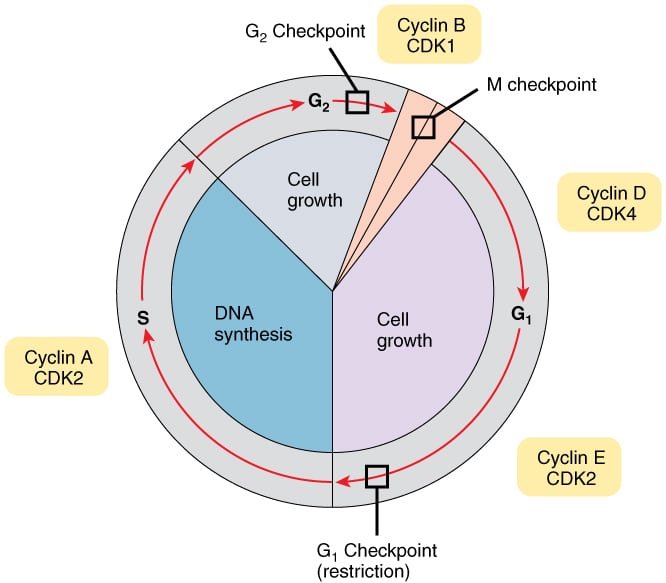Cell cycle and cell cycle regulation: The cell cycle is divided into three stages - interphase, mitosis and cytokinesis. Interphase is the period between successive rounds of nuclear division and is characterized by cell growth and synthesis of new DNA. Interphase is further divided into G1, S and G2 phases. Division of genetic material occurs during mitosis and is divided into prophase, pro-metaphase, metaphase, anaphase and telophase. Cytokinesis is the phase of division of the cytoplasmic material.
Following are the phases of interphase -
i) G1 and G0: G0 or resting phase is seen when the cell is in quiescent state. Cells in G0 are not dividing. Permanent cells remain in G0, while other cells will transit from G0 to G1 phase when they enter the cell cycle to undergo cell division. During G1 , cells will grow, RNA and protein synthesis occurs and organelles and intracellular structures are duplicated. Length of the G1 phase differs between cells, with the time being lesser in rapidly dividing cells and vice versa.
ii) S phase: Synthesis of nuclear DNA and DNA replication occurs during S phase. Cells will replicate their DNA content and go from 2N to 4N at the end of S phase. N stands for each copy of chromosome, so that 2N means 2 copies of the same chromosome. Haploid is 1N while diploid is 2N.

iii) G2 phase: It is the phase between S phase and mitosis
Following phases are seen in mitosis -
i) Prophase: Genetic material condenses into chromatids, each of them being connected to another in a pair by a centromere. Protein complexes called kinetochores are formed that attach to the chromatids. Mitotic spindle is formed while the nucleolus disassembles.
ii) Prometaphase: Nuclear envelope disassembles . Microtubules of the mitotic spindle attach to kinetochores, allowing the chromosomes to be pulled apart.
iii) Metaphase: Chromosomes are aligned at the equator of the mitotic spindle.
iv) Anaphase: The centromere splits, sister chromatids are separated and move to opposite poles of the mitotic spindle. Kinesins push apart the spindle to elongate it.
v) Telophase: Mitotic spindle disassembles, nuclear envelope forms around each set of chromatids at the poles, chromatids decondense and nucleoli are formed again in the daughter nuclei. 2 daughter nuclei are formed from each nucleus.
Following events happen in cytokinesis -
i) Actin microfilament ring forms and contracts to produce a cleavage furrow.
ii) Furrow deepens and separates the cell into two daughter cells.
Regulation of cell cycle: The timing of events in the cell cycle are orchestrated by the expression of cyclins. Cyclins bind and activate CDKs or cyclin dependent kinases that phosphorylate several structural proteins and enzymes, triggering different cell cycle events. There are four classes of cyclins that are expressed during different stages of the cell cycle - cyclin D (G1), cyclin E (G1/S), cyclin A (S) and cyclin B (mitosis). Following CDKs are expressed in different stages of the cell cycle - CDK4 and CDK6 (G1), CDK2 (G1/S, and S), CDK1 (mitosis). Gene expression of a cyclin is turned just before its stage of the cell cycle, and once its stage is complete, the cyclin is ubiquitinated and targeted for degradation by the proteasome. Cyclins activate CDKs by inducing a conformational change in CDKs that open an ATP-binding pocket. CDK activity is also regulated by phosphorylation.
Cyclin D turns on the expression of G1/S and S cyclins. DNA damage also inhibits the cell cycle by inhibiting the activation of G1/S-CDK complexes. Expression of G1/S cyclins is regulated by E2F proteins, which are transcription activators. Rb proteins bind to and inhibit the activity of E2F1, E2F2, and E2F3. Other Rb family proteins, p107 and p130, function as corepressors with E2F4 and E2F5. Mitogens stimulate cell division by increasing the amount of G1 cyclins.
Ink4 proteins bind to cyclin D-CDK and inhibit its activity. Expression of Ink4 is increased in the presence of the transcription protein Miz1, which in turn is activated by TGF beta. Mitogens lower the expression of Ink4 proteins.
TOR (target of rapamycin), a serine/threonine signalling pathway, is considered the master regulator of growth rates in cells as it increases the expression of ribosome proteins and RNAs and it increases the rate of translation. Growth factors like IGF 1 and hormones stimulate the activity of TOR.
Checkpoints monitor the progress of cell cycle events and prevent entry into subsequent stages until the current stage is completed. Three checkpoints monitor the progress of the cell cycle and regulate the activity of cyclin-CDK complexes.
i) G1 checkpoint: The restriction point is seen in G1 phase, any cell that passes this checkpoint will continue with cell division. In the presence of DNA damage, tumor suppressor proteins halt the cell cycle before it reaches the restriction point. Mutations in tumor suppressor genes will allow a cell with damaged DNA to divide thus causing cancer. The G1 checkpoint also makes sure that cells do not enter the S phase before the completion of the G1 phase.
ii) S phase checkpoint: In the presence of DNA damage in S phase, DNA synthesis and cell cycle are slowed. BRCA 1 plays a role in the repair of double stranded DNA breaks in the S phase.
iii) G2 checkpoint: It is seen before transitioning from G2 to M phase. CDK1 is inactivated by phosphorylation throughout G1 and S phases. In G2, CDK1 is dephosphorylated by cdc25C phosphatase, which allows it to bind to and activate Cyclin B, so that the G2 phase can move forward. Tumor suppressors ATM and ATR inhibit cdc25C phosphatase and halt the cell in G2, when needed.
Sign up for free to take 2 quiz questions on this topic